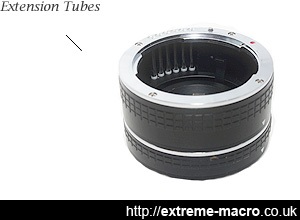Extreme Macro Extension Tubes
by Johan J Ingles-Le Nobel
Last updated August 31, 2017
They're often the first step into getting into extreme macro, so I've included a brief writeup of extension tubes for the sake of macro completeness.

3rd party K mount extension tubes, not the most complex of accessories but a great way into the world of extreme macro. The vertical lines at the back are the conductors for the contacts. Full aperture reading K mount extension tubes are quite hard to find, and you have to look at old 3rd party models like a Kenko set. Extension tubes can also be used to solve the portrait problem.
There's not that much that can really be said about extension tubes but for what it's worth, once you've got a decent set you'll keep using them as they're very handy out in the field and easier to use there than a bulky old set of bellows.
What is an Extension Tube?
An extension tube adds tube length between your lens and your camera, and typically they come in sets of 3 so you can choose to use just the smallest extension, add a couple together for a different length or use all 3 together.
The effect of adding an extension tube onto your length is simply to add a bit of magnification. In other words, add an extension tube onto your camera and it'll let you have more magnification on a macro shot. You can use the calculator below to work out what the effect of an extension tube will be:
Using an Extension Tube
The thing about using an extension tube is that it potentially gives you two complications. The first is infinity focus - lenses that focus at infinity without an extension tube may and probably will lose the ability at infinity with an extension tube mounted.
once you've got a decent set you'll keep using themSome lenses focus beyond infinity and can theoretically focus at infinity with a small extension tube mounted, but that's more of a theoretical possibility than one that I've actually come across.
The second complication is lighting, as many extension tubes don't provide lens aperture information to the camera. Each system requires its own means to then get good lighting information.
Look for
I have three sets: two cheap metal basic tubes and one slightly fancier one that communicates lens information with the camera.
If you can, get one of these, but beyond Extension tubes can also be used to solve the portrait problem that look for a sturdily made extension tube as they have to take a considerable strain especially if you like to use long lenses on tubes. This can buckle the mount if you have a flimsy set which you don't really want. A cheap no-communication set of extension tubes costs about a tenner or so on eBay, but a fancier set can cost upwards of £50.
Starting Out With Tubes
There is nothing especially difficult about using extension tubes for macro. Extension tubes are a simple way to start out in extreme macro without breaking the bank, if you're prepared to put up with the lack of certain electronic functions. Just buy a super cheap set of tubes in the mount of your camera, and make sure that you have the necessary adapters to reverse mount a super cheap old 28 or 35mm lens in reverse on the end. Anything below 50mm, reverse it with a reverse adapter for better performance - see http://extreme-macro.co.uk/extreme-macro-reversed-lenses/. For the lens that you reverse, make sure that it has manual aperture settings on a ring that you can adjust.
Do bear in mind that whilst extension tubes are a cheap way to get into extreme macro, they're not necessarily optically the best. Although tubes, being empty, don't add any extra aberrations into the mix, what they might to is cause the optical aberrations of a non-macro lens to be magnified. So if you're using a standard lens on the end of tubes, this might not be optimised for flatness of field, or even for a close distance, and that would be magnified by the effect of using extension tubes.
But if you just want to experiment a bit with macro, and don't want to invest a lot of money into buying things, buy a set of macro extension tubes and have some fun using them on lenses that you already have. Don't buy the cheapest - go for fun and if you are a Nikon or Canon user, get chipped extension tubes (they have electronic contacts, so that your lens can auto focus and you can change the aperture).
Check For Light Leaks
One thing to be aware of with extension tubes (and even bellows) is that there are sometimes light leaks, either between the joined sections of the tubes or the adapters that fit onto your camera or fit the lens. The machining of these parts isn't always as tight fitting or exact as we might all like and when they don't quite fit together they might let a tiny bit of stray light in. This is pretty fatal for your extreme macro shot as these tend to be at a very low light level already, and there are a couple of ways that I've found to deal with this.
The first is just black electrician's tape - this can be used to tape over the fittings to make sure there's no light going in there. But another way is just plain old aluminium foil, wrapped round the tube. I use something fancier myself that I had left over from another project, Rosco Matte Black Cinefoil. This is basically black aluminium foil that I've used before to shape light, but has a use as masking foil to prevent stray light as well.
Related Articles




